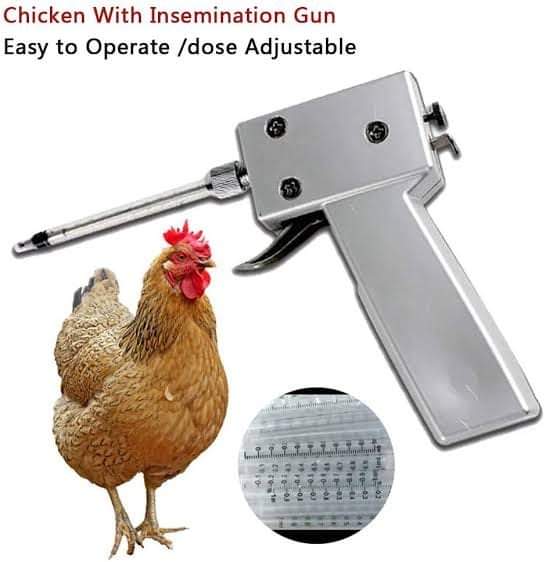A𝗿𝘁𝗶𝗳𝗶𝗰𝗶𝗮𝗹 𝗶𝗻𝘀𝗲𝗺𝗶𝗻𝗮𝘁𝗶𝗼𝗻 (AI) 𝗶𝗻 commercial 𝗽𝗼𝘂𝗹𝘁𝗿𝘆
Artificial insemination (AI) in simple mean manual transfer of semen into the female’s vagina. The credit of first successful AI goes to Spallanzani and Bonnet in dogs (1784). The technique was first used in birds at 1907 by Ivano. Basically it is a two-step procedure: first, collecting semen from the male and then inseminating the semen into the female. The chicken semen is not able to be preserved as that of bull semen. Artificial Insemination (AI) is an important tool to improve the reproductive performance of birds especially broiler and layer breeders.
𝗣𝗼𝗶𝗻𝘁𝘀 𝗳𝗼𝗿 𝗦𝗲𝗹𝗲𝗰𝘁𝗶𝗼𝗻 𝗼𝗳 𝗠𝗮𝗹𝗲
Male should be fully sexually matured.
There should be no physical or genital defects in male.
Male should be superior in flock.
Tame and free from any external parasites.
Not terrified when restrained or handled.
Kept apart from, but preferably in sight of females.
𝗣𝗼𝗶𝗻𝘁𝘀 𝗳𝗼𝗿 𝗦𝗲𝗹𝗲𝗰𝘁𝗶𝗼𝗻 𝗼𝗳 𝗳𝗲𝗺𝗮𝗹𝗲
Must be in production or the birds not in injured.
Must be free from defects.
Female should be fully sexually matured.
𝗚𝗲𝗻𝗲𝗿𝗮𝗹 𝗣𝗼𝗶𝗻𝘁𝘀
One cock will yield about 0.5 to 1.0 ml of semen depending upon the body weight.
At 35 to 40 weeks of age, the semen production is high.
After 40 weeks the semen production declines.
05 to 0.10 ml of semen is enough to inseminate one hen.
For better fertility semen is collected thrice in a week from a cock and insemination is done in a hen once in a week.
Semen collected from one cock is sufficient for inseminating 5 to 10 hens depending upon the semen volume and sperm concentration.
A cock can fertilize 6-10 hens in a flock. But in case of artificial insemination it is claimed this ratio could be increased fourfold.
In case of artificial insemination from 6-8 males’ semen can be inseminated 150-170 females.
At farms, where AI is practiced the males are kept separately in individual cages where sufficient space is available for movement of the birds.
Rough handling should be avoided, if not it may develop fear reaction, which affects the semen volume during ejaculation.
The method of semen collection poultry is by massage method.
Semen was collected twice in a week.
A.I Consists of Three Operations:
Stimulating the male to ejaculate semen
Everting the cloaca of the female.
Insemination.
𝗣𝗿𝗼𝗰𝗲𝗱𝘂𝗿𝗲
The pullet is held in the left hand, head down with its back resting against person’s chest, the feathers below the vent can be clipped or pressed downward.
At the same time, the bird’s abdomen is compressed gently but firmly with other hand.
By this cloaca the cloaca becomes everted.
The vent region is forced to evert, exposing the opening of the cloaca into the vagina.
By this compression faeces can be excreted.
When evertion is accomplished the insemination instrumentis inserted about an inch into the vaginal opening before applying pressure to eject the semen.
About 0.02 to 0.05 ml of semen is sufficient for successful fertilization.
Inseminate female once a week.
Insemination should be done after 3 P.M. or in afternoon, by this time most of the birds have completed their laying and their oviduct will remain empty.
Pic 3: Insemination with AI Gun
Dose and Frequency of Insemination
Chicken : 0.05 ml, once in a week.
Turkey : 0.025 ml once in every 2 weeks
Ducks : 0.03 ml once in every 5 days
Goose : 0.05 ml for every 7 days.
It has been observed that the males produce more semen of good quality during morning and females produce more fertile eggs when inseminated around 9 p.m.
Semen volume and sperm concentration in different species of poultry
𝗔𝗱𝘃𝗮𝗻𝘁𝗮𝗴𝗲𝘀
Increased mating ratio: with artificial insemination the general ratio could be increased by ten times.
Male with outstanding characteristics can be used for several generation, where in under natural mating its limited.
Male with physical injuries still used.
Can get more number of fertile eggs in a laying rate in short increases fertility or breeding rate.
Source-Dr.Surinder khana



